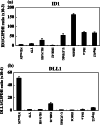Gene expression profiling of human neural progenitor cells following the serum-induced astrocyte differentiation
- PMID: 19130216
- PMCID: PMC11506025
- DOI: 10.1007/s10571-008-9338-2
Gene expression profiling of human neural progenitor cells following the serum-induced astrocyte differentiation
Abstract
Neural stem cells (NSC) with self-renewal and multipotent properties could provide an ideal cell source for transplantation to treat spinal cord injury, stroke, and neurodegenerative diseases. However, the majority of transplanted NSC and neural progenitor cells (NPC) differentiate into astrocytes in vivo under pathological environments in the central nervous system, which potentially cause reactive gliosis. Because the serum is a potent inducer of astrocyte differentiation of rodent NPC in culture, we studied the effect of the serum on gene expression profile of cultured human NPC to identify the gene signature of astrocyte differentiation of human NPC. Human NPC spheres maintained in the serum-free culture medium were exposed to 10% fetal bovine serum (FBS) for 72 h, and processed for analyzing on a Whole Human Genome Microarray of 41,000 genes, and the microarray data were validated by real-time RT-PCR. The serum elevated the levels of expression of 45 genes, including ID1, ID2, ID3, CTGF, TGFA, METRN, GFAP, CRYAB and CSPG3, whereas it reduced the expression of 23 genes, such as DLL1, DLL3, PDGFRA, SOX4, CSPG4, GAS1 and HES5. Thus, the serum-induced astrocyte differentiation of human NPC is characterized by a counteraction of ID family genes on Delta family genes. Coimmunoprecipitation analysis identified ID1 as a direct binding partner of a proneural basic helix-loop-helix (bHLH) transcription factor MASH1. Luciferase assay indicated that activation of the DLL1 promoter by MASH1 was counteracted by ID1. Bone morphogenetic protein 4 (BMP4) elevated the levels of ID1 and GFAP expression in NPC under the serum-free culture conditions. Because the serum contains BMP4, these results suggest that the serum factor(s), most probably BMP4, induces astrocyte differentiation by upregulating the expression of ID family genes that repress the proneural bHLH protein-mediated Delta expression in human NPC.
Figures








Similar articles
-
Upregulation of the HLH Id gene family in neural progenitors and glial cells of the rat spinal cord following contusion injury.J Neurosci Res. 2001 Dec 15;66(6):1161-72. doi: 10.1002/jnr.10089. J Neurosci Res. 2001. PMID: 11746449
-
Stable expression of neurogenin 1 induces LGR5, a novel stem cell marker, in an immortalized human neural stem cell line HB1.F3.Cell Mol Neurobiol. 2010 Apr;30(3):415-26. doi: 10.1007/s10571-009-9466-3. Epub 2009 Oct 8. Cell Mol Neurobiol. 2010. PMID: 19813087 Free PMC article.
-
Differential regulation of basic helix-loop-helix factors Mash1 and Olig2 by beta-amyloid accelerates both differentiation and death of cultured neural stem/progenitor cells.J Biol Chem. 2007 Jul 6;282(27):19700-9. doi: 10.1074/jbc.M703099200. Epub 2007 May 8. J Biol Chem. 2007. PMID: 17488716
-
Fetal human hematopoietic stem cells can differentiate sequentially into neural stem cells and then astrocytes in vitro.J Hematother Stem Cell Res. 2003 Feb;12(1):23-32. doi: 10.1089/152581603321210109. J Hematother Stem Cell Res. 2003. PMID: 12662433
-
Context dependence of proneural bHLH proteins.Curr Opin Genet Dev. 2008 Oct;18(5):411-7. doi: 10.1016/j.gde.2008.07.012. Epub 2008 Sep 7. Curr Opin Genet Dev. 2008. PMID: 18722526 Free PMC article. Review.
Cited by
-
Astrocytes Can Adopt Endothelial Cell Fates in a p53-Dependent Manner.Mol Neurobiol. 2017 Aug;54(6):4584-4596. doi: 10.1007/s12035-016-9974-3. Epub 2016 Jul 8. Mol Neurobiol. 2017. PMID: 27389775 Free PMC article.
-
Defects in early synaptic formation and neuronal function in Prader-Willi syndrome.Sci Rep. 2023 Jul 25;13(1):12053. doi: 10.1038/s41598-023-39065-x. Sci Rep. 2023. PMID: 37491450 Free PMC article.
-
Neutrophils Induce Astroglial Differentiation and Migration of Human Neural Stem Cells via C1q and C3a Synthesis.J Immunol. 2017 Aug 1;199(3):1069-1085. doi: 10.4049/jimmunol.1600064. Epub 2017 Jul 7. J Immunol. 2017. PMID: 28687659 Free PMC article.
-
Generation of immortal cell lines from the adult pituitary: role of cAMP on differentiation of SOX2-expressing progenitor cells to mature gonadotropes.PLoS One. 2011;6(11):e27799. doi: 10.1371/journal.pone.0027799. Epub 2011 Nov 21. PLoS One. 2011. PMID: 22132145 Free PMC article.
-
de novo MEPCE nonsense variant associated with a neurodevelopmental disorder causes disintegration of 7SK snRNP and enhanced RNA polymerase II activation.Sci Rep. 2019 Aug 29;9(1):12516. doi: 10.1038/s41598-019-49032-0. Sci Rep. 2019. PMID: 31467394 Free PMC article.
References
-
- Andres-Barquin PJ, Hernandez MC, Hayes TE, McKay RD, Israel MA (1997) Id genes encoding inhibitors of transcription are expressed during in vitro astrocyte differentiation and in cell lines derived from astrocytic tumors. Cancer Res 57:215–220 - PubMed
-
- Brguljan PM, Turk V, Nina C, Brzin J, Krizaj I, Popovic T (2003) Human brain cathepsin H as a neuropeptide and bradykinin metabolizing enzyme. Peptides 24:1977–1984. doi:10.1016/j.peptides.2003.09.018 - PubMed
-
- Brunet JF, Grollimund L, Chatton JY, Lengacher S, Magistretti PJ, Villemure JG, Pellerin L (2004) Early acquisition of typical metabolic features upon differentiation of mouse neural stem cells into astrocytes. Glia 46:8–17. doi:10.1002/glia.10348 - PubMed
-
- Cai L, Morrow EM, Cepko CL (2000) Misexpression of basic helix-loop-helix genes in the murine cerebral cortex affects cell fate choices and neuronal survival. Development 127:3021–3030 - PubMed
Publication types
MeSH terms
Substances
LinkOut - more resources
Full Text Sources
Medical
Research Materials
Miscellaneous

